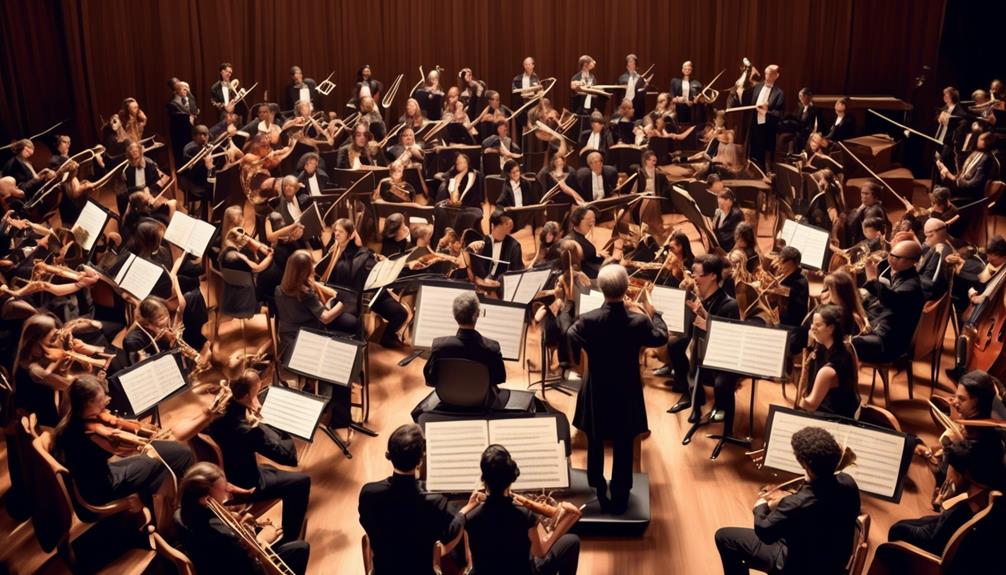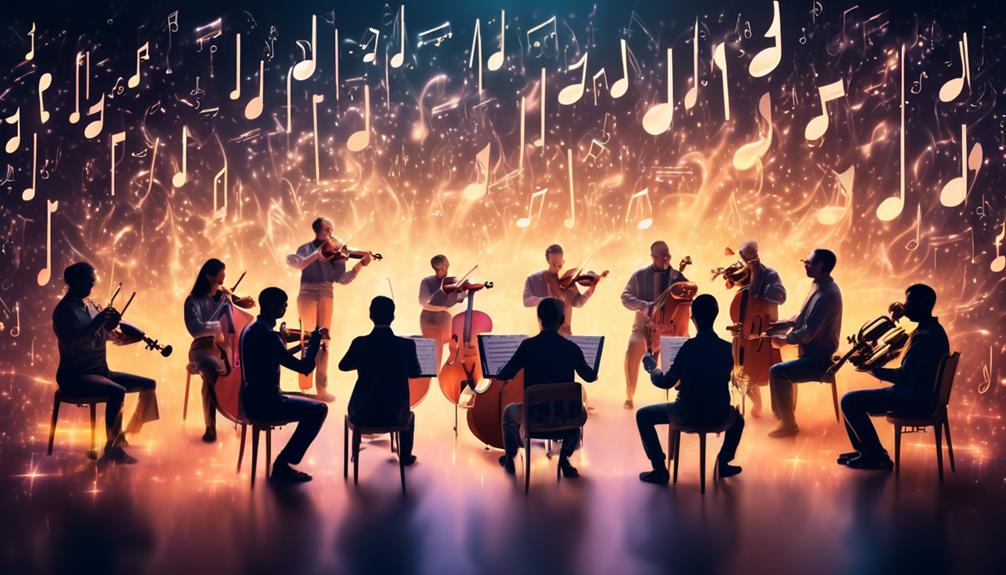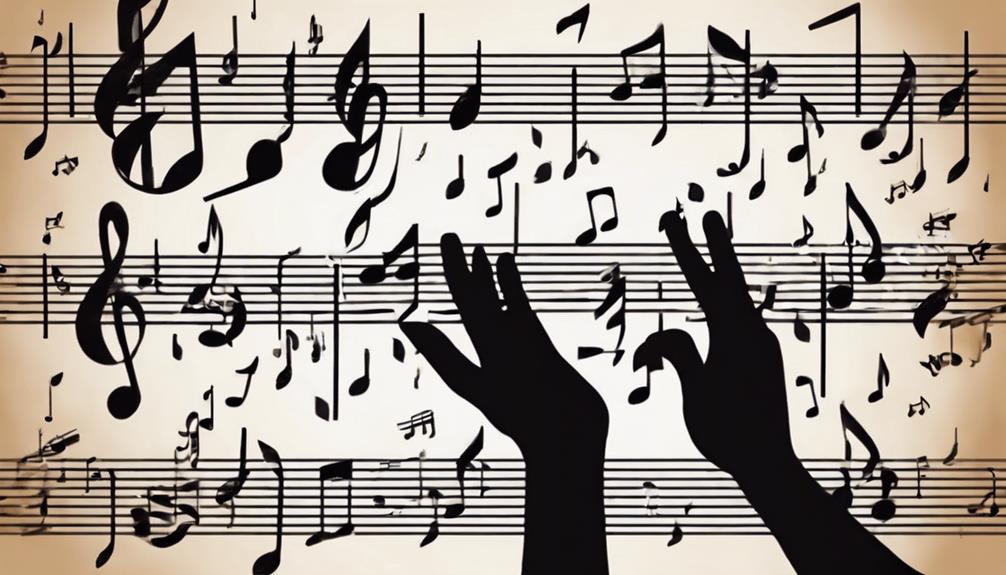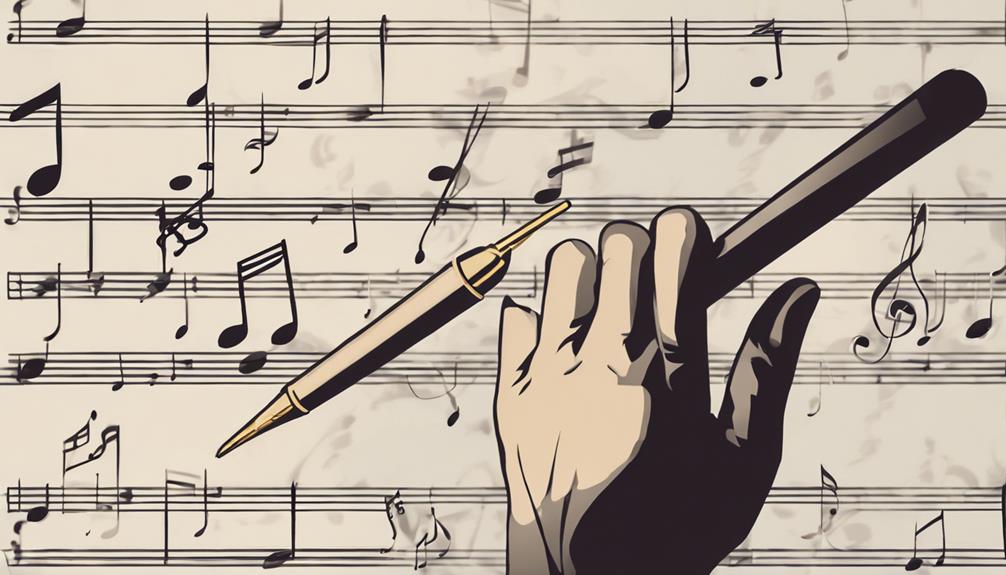No products in the cart.
Just as a painter must understand the principles of light and shadow to bring a canvas to life, you need to grasp the fundamentals of music arrangement to infuse a song with vibrancy and depth.
These essentials serve as the scaffolding for constructing a piece that resonates with listeners, providing a framework that supports melody, harmony, and rhythm.
You’ll find that mastering these elements not only sharpens your technical skills but also enhances your creative expression, allowing you to communicate with your audience more effectively.
Still, the question lingers: how can these building blocks transform a simple tune into a masterpiece that captures the essence of human emotion and experience?
As you explore the intricate dance of arranging notes and instruments, you’ll uncover the subtle magic that turns a collection of sounds into an unforgettable musical journey.
Key Takeaways
- Creative spacing and meticulous placement of notes and rhythms are essential in music arrangement.
- Understanding musical form allows for bending the rules and eliciting a strong emotional response.
- Instrumentation choices are about crafting an experience and considering how sounds complement each other.
- Mastering rhythm and groove infuses music with life and captivates listeners.
Arrangement Fundamentals
Delving into the core of music arrangement, you’ll discover that it’s an art form balancing technical skill with creative expression, where each note and rhythm is meticulously placed to craft the sonic landscape of a piece.
Creative spacing isn’t just about where the notes fall; it’s about the breathing room between them, the silence that cradles the sound. It’s a principle that allows for clarity, ensuring that each voice or instrument is heard and felt within the tapestry of the arrangement.
As you refine your technique, you’ll encounter the counterpoint introduction, a method that weaves independent melodies into a harmonious dialogue. It’s a dance of dynamics, pitch, and tempo, where themes converse and sometimes clash, only to resolve in a satisfying union.
The counterpoint isn’t merely a technique; it’s a philosophy, one that champions the interplay of distinct musical ideas, creating a complex yet cohesive whole.
Understanding Musical Form
Grasping musical form unlocks the blueprint of a composition, allowing you to navigate the intricate layers and transitions that give a piece its unique narrative flow. As you delve into musical form analysis, you’re not just dissecting a static diagram; you’re engaging with a dynamic, evolving process. Compositional techniques become the tools with which you craft and understand this process, shaping the emotional and intellectual journey for your audience.
Imagine the possibilities when you:
- Master the narrative arc of sonata form
- Experience the tension and release in the development
- Revel in the familiarity of the recapitulation
- Embrace the contrast within ternary form
- The poignant return to A after exploring the contrasting B section
- The satisfaction as the opening theme reasserts itself
Your technical prowess intertwines with creativity, allowing you to structure a piece that’s both innovative and familiar. Studying musical form isn’t just about learning the rules; it’s about knowing when to bend them to elicit the strongest emotional response. By understanding the architecture of music, you become a storyteller, wielding notes and rhythms to captivate and move your audience.
Instrumentation Choices

When you select the instruments for your arrangement, you’re painting with sound, each choice adding a distinct color and texture to your musical canvas. The importance of timbre cannot be overstated; it’s the quality that defines each instrument’s sound. Your orchestration techniques must take advantage of this, creating a blend where each timbre can shine or merge seamlessly.
Here’s a snapshot of how different instruments can influence your arrangement:
| Instrument Group | Tone Color | Texture Role |
|---|---|---|
| Strings | Warm, Rich | Foundation |
| Brass | Bold, Brassy | Accent |
| Woodwinds | Delicate, Mellow | Ornamentation |
Understanding the unique capabilities and tonal qualities of each instrument is crucial. You wouldn’t just toss a flute into a heavy brass section without considering how it’ll cut through or complement the mix. Likewise, balancing a cello’s depth with the brightness of a violin requires finesse.
Instrumentation choices are about more than just picking sounds; they’re about crafting an experience. As you dive into arranging, remember that cohesion and balance are key. Your choices should reflect a keen understanding of how instruments interact, ensuring that your musical story is told with clarity and innovation.
Rhythm and Groove
At the heart of any compelling music arrangement lies the rhythm and groove, the elements that give your creation its pulse and sway. Mastering these aspects isn’t just about keeping time; it’s about infusing your music with life, making listeners’ hearts beat in sync with your tune.
To innovate and captivate, you need to understand how rhythmic variations and syncopation techniques can transform a simple beat into a complex tapestry of sound.
- Rhythmic Variations
- *Alter the length of notes to create tension and release.*
- *Introduce off-beat accents for an unexpected twist.*
- Syncopation Techniques
- *Emphasize the weak beats to defy expectations.*
- *Craft rhythms that interact with the melody in surprising ways.*
Harmony Essentials


As you orchestrate your musical piece, the construction of chord progressions serves as the scaffold, dictating the emotional trajectory.
Mastering voice leading techniques ensures that each note transitions smoothly, lending coherence and elegance to your harmonies.
Moreover, layering harmonic textures can add depth and complexity, enriching the tapestry of sound you’re weaving.
Building Chord Progressions
Delving into the heart of music creation, you’ll find that crafting compelling chord progressions is a fundamental skill for establishing the harmonic framework of any song. Utilizing chord inversions and modulation effects not only adds depth but also captivates your listener’s ear with an innovative harmonic journey.
- Chord inversions:
- Transform a mundane progression into a sophisticated tapestry
- Facilitate smooth transitions between chords
- Modulation effects:
- Propel the music forward with dynamic shifts
- Stir emotions by navigating through different keys
Harness these tools to sculpt a rich sonic landscape. As you assemble chords with intention, you’re not just building a sequence; you’re architecting an emotional experience. It’s this meticulous construction that resonates with the innovators and dreamers, eager for the next auditory revelation.
Voice Leading Techniques
Mastering voice leading techniques is crucial for ensuring that each chord transition in your composition flows seamlessly, creating a polished and expressive musical narrative. These techniques are the skeleton that supports the body of your harmonic structure.
They guide each voice, or musical line, to move smoothly from one chord to the next, weaving a tapestry of sound that feels natural and intuitive.
Harmonic Texture Layers
To craft a musical piece with depth and emotional resonance, it’s essential to grasp how harmonic texture layers can be meticulously interwoven to create rich, complex soundscapes. You’ll tap into the power of harmony by mastering:
- Different chord inversions
- Flip the script on traditional harmonies
- Engineer freshness in repetitive chord progressions
- Chord voicings
- Space out notes for a lush, expansive effect
- Cluster tones for an intense, emotionally charged atmosphere
Innovative use of these techniques won’t only enhance the emotional narrative of your music but also give it a distinctive edge.
Think of each layer as a brushstroke in a sonic painting, with every inversion and voicing adding a shade of meaning to your aural canvas.
Melodic Development


Exploring melodic development, you’ll uncover the art of breathing life into a simple tune by skillfully expanding and transforming its core motifs to captivate your audience. When you delve into the realm of exploring motifs, you’re engaging with the building blocks of your melody.
Through the lens of melodic variation, these motifs become the canvas for your creativity, with each stroke of augmentation, diminution, or fragmentation adding a new layer of emotional resonance.
As you weave the fabric of your musical narrative, consider how sequence can propel your melody forward, instilling a sense of movement and growth. Augmentation, the art of stretching motifs, lends a grandiose air, expanding the sonic space. Diminution, in contrast, quickens the pace, offering a sense of urgency or playful agility. Fragmentation breaks down motifs into smaller, compelling pieces, inviting the listener to lean in as you reassemble them into something unexpectedly new.
Texture and Sound Design
As you explore the realm of texture and sound design, consider how layering instrumental voices can sculpt the auditory space of your arrangement.
You’re not just choosing sounds; you’re crafting tone colors that paint your musical canvas with depth and emotion.
Each background murmur or textured echo you select either forges a path of contrast or weaves a thread of continuity, shaping the listener’s journey through your sonic landscape.
Layering Instrumental Voices
How can you transform a simple melody into a rich tapestry of sound? Layering instrumental voices is the key, adding depth and complexity to your music through thoughtful texture and sound design. By mastering blending techniques, you amplify the emotional impact, ensuring each note resonates with your audience.
Here’s how:
- Texture
- Weave a harmony that complements the lead
- Introduce rhythmic undercurrents for momentum
- Sound Design
- Craft distinctive timbres that define your sonic signature
- Manipulate dynamics to highlight emotional peaks and valleys
Innovation in layering is more than adding sounds; it’s about creating a cohesive whole where each element supports and enhances the other, ensuring your music not only sounds professional but also touches the heart and soul of your listeners.
Crafting Tone Colors
Building on the concept of layering instrumental voices, let’s focus on how crafting tone colors through texture and sound design can elevate your music’s emotional landscape.
The nuance of timbre distinguishes your soundscapes, making them unique and evocative. By experimenting with effects, you’re able to sculpt the sonic space, adding dimensions that resonate with your audience’s senses. Think of it as painting with sound; each brushstroke is a carefully chosen texture that contributes to the overall picture.
Utilizing synthesis techniques, you can mold the raw materials of your composition, giving life to innovative aural motifs. This is where creativity meets technology, resulting in a rich tapestry of auditory expressions. The strategic blend of these elements doesn’t just fill the ears; it stirs the soul, allowing your music to leave a profound, lasting impression.
Dynamics and Expression


Why does a subtle crescendo or a sudden forte capture our attention in a musical piece? When you’re exploring dynamics and utilizing expressive techniques, you’re not just playing notes—you’re telling a story. Dynamics and expression are the heartbeat of a musical narrative, adding dimension and color where mere notes cannot.
They serve as the brushstrokes of your sonic painting, shaping:
- Contrasts: A sudden drop to pianissimo after a fortissimo section isn’t just a change in volume—it’s an unexpected twist that can make hearts skip a beat.
- Progressions: A gradual crescendo builds anticipation, guiding listeners towards a climactic moment that can release pent-up emotions.
As a sonic innovator, it’s your task to master these elements, to coax out the spirit of each phrase. You must control the ebb and flow of intensity, using dynamics and expression to:
- Craft peaks and valleys that:
- Engage: The dynamic shifts keep listeners on the edge of their seats, eager for the next chapter in your musical saga.
- Express: Through varied intensities, you communicate the nuances of emotion, from the gentle caress of a piano to the bold declaration of a forte.
Harness these tools, and you’ll transform notes into a living, breathing organism that resonates with the vibrancy of life itself.
Arranging for Genres
As you orchestrate your piece, you’ll find that each genre’s soul breathes through its instruments—choose wisely to capture that essence.
Tempo and rhythm aren’t merely a backdrop; they’re the heartbeat that gives each style its distinct pulse.
Explore harmonic structures with a keen ear for the genre’s tonal language, ensuring your arrangement resonates with authenticity.
Genre-Specific Instrumentation Choices
Delving into the heart of musical genres, your arrangement’s authenticity hinges on the strategic selection of genre-specific instrumentation. Mastering instrumentation techniques and genre-specific arranging techniques is essential. Each genre speaks its own sonic language, and it’s your job to become fluent.
- Harnessing the power of instrumentation:
- Rock: Electric guitars, bass, drums, and perhaps a touch of keyboard
- Jazz: Saxophones, trumpets, double bass, and a piano’s rhythmic flair
- Classical: A lush string section complemented by woodwinds and brass
- Electronic: Synthesizers, drum machines, and the pulse of digital soundscapes
Your innovative spirit thrives when you blend these sounds to evoke the desired emotional response, crafting a tapestry that resonates with the soul of the genre and the hearts of your audience.
Tempo and Rhythm Variations
Having explored the essential instruments that define various genres, let’s now focus on how manipulating tempo and rhythm can further tailor your arrangement to fit the mold of your chosen style.
Delving into exploring tempo variations isn’t just about speed; it’s about crafting the pulse that anchors your listeners’ experiences. A slight acceleration might breathe excitement into a rock anthem, while a measured deceleration can add gravitas to a ballad’s climax.
Infusing rhythmic complexity, you’ll weave intricate patterns that command attention. This isn’t random experimentation—it’s strategic, nuanced design. You’re sculpting silence and sound into a tapestry that reflects the genre’s soul.
Master these tempo and rhythm variations, and your arrangements will resonate with authentic vibes, making them not just heard but deeply felt.
Harmonic Structures Exploration
In the realm of music arrangement, a deep dive into harmonic structures is pivotal for crafting the true essence of any genre. You’re not just manipulating chords; you’re delving into the soul of the music, shaping its emotional core through tonal variations and modal exploration.
Each genre whispers its secrets through its harmonic tendencies:
- Jazz
- Swing with *extended chords* and *substitutions*
- Feel the *modal exploration* that defies expectations
- Pop
- Connect with *four-chord loops*
- Relate through *predictable progressions* with creative twists
Your role is to listen and translate these harmonic languages, innovatively intertwining them into arrangements that resonate. Balance technical mastery with creative flair, and you’ll not only understand but also redefine the genres you touch.
Practical Arrangement Tips
While mastering the art of arrangement, you’ll find that applying a few practical tips can significantly enhance the coherence and impact of your musical pieces. Let’s dive into a strategy that’s as innovative as it is technical: creative spacing. By utilizing arrangement software, you can visually and aurally experiment with the distribution of musical elements across your soundscape. The software enables you to place each instrument precisely, ensuring that every note and chord has its own sonic “breathing room.”
To illuminate these concepts, consider the table below:
| Technique | Description | Benefit |
|---|---|---|
| Layering | Stacking harmonies or melodies | Adds texture and depth |
| Dynamics | Varying volume levels | Creates emotional impact |
| Panning | Distributing sound in stereo field | Achieves a realistic feel |
| Contrast | Incorporating distinct musical ideas | Maintains listener interest |
| Repetition | Reusing musical motifs | Establishes familiarity and structure |
Frequently Asked Questions
Why Is Arrangement Important in Music?
You’ll find that arrangement shapes a song’s soul, weaving harmonic texture and rhythmic patterns to captivate listeners. It’s the blueprint that transforms raw melodies into polished, innovative auditory experiences.
Why Is It Important to Understand the Fundamentals of Music?
You’ll need a solid grasp of melody crafting and rhythm understanding to innovate and push musical boundaries. This technical foundation ensures your compositions are structured yet creative, resonating with a forward-thinking audience.
What Is the Importance of the Music Arranger?
You’re the arranger, wielding creative control to shape a song’s soul. Your role’s pivotal; you craft layers, inject personality, and dictate the emotional journey, all while balancing technical mastery with innovative structure.
What Is the Basic of Music Arrangement?
You’ll find that the basics of music arrangement hinge on deliberate instrument selection and harmony dynamics, vital for crafting innovative, technically sound pieces that resonate structurally and emotionally with your audience.
Conclusion
In mastering arrangement fundamentals, you’re sculpting music’s raw clay into art. Each choice, from the ebb of dynamics to the weave of harmony, shapes your song’s impact. You’re not just filling space; you’re creating a sonic journey.
Whether blending textures or tailoring rhythms to genres, you’re the architect of emotion. So, harness these tools with precision—your arrangement isn’t just a blueprint; it’s the soul of your musical vision brought to life.




